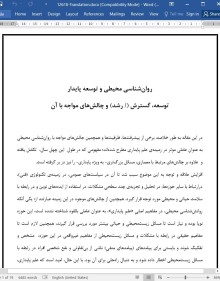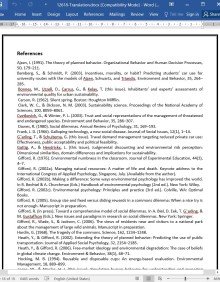
دانلود مقاله روان شناسی محیطی و توسعه پایدار، گسترش (/ رشد) و چالش های مواجه با آن
در این مقاله به طور خلاصه، برخی از پیشرفتها، ظرفیتها و همچنین جالشهای مواجه با روانشناسی محیطی به عنوان عاملی موثر در زمینهی علم پایداری مطرح شدهاند؛ مفهومی که در طول این چهل سال، تکامل یافته و علاوه بر چالشهای مرتبط با معماری، مسائل بزرگتری- به ویژه پایداری- را نیز در بر گرفته است.
افزایش علاقه و توجه به این موضوع سبب شد تا آن در سیاستهای عمومی، در زمینهی تکنولوژی (فنی)، درارتباط با سایر حوزهها، در تحلیل و تجزیهی چند سطحیِ مشکلات، در استفاده از ایدهههای نوین و در رابطه با سلامت حیاتی و محیطی مورد توجه قرار گیرد. همچنین از چالشهای موجود در این زمینه عبارتند از؛ یکی آنکه روانششناسیِ محیطی، در مفاهیم اصلیِ «علمِ پایداری»، به عنوان عاملی بالقوه شناخته نشده است، این حوزه نوپا بوده و نیاز است تا مسائل زیستمحیطی و حیاتی بیشتر مورد بررسی قرار گیرند، همچنین لازم است تا مفاهیم حقیقی در رابطه با مشکلات و مسائل زیستمحیطی از مفاهیم غیرواقعی در این حوزه، مشخص و تفکیک شوند و بایستی برای پیامدهای (پیامدهای منفیِ) ناشی از بیتفاوتی و نفع شخصیِ افراد در رابطه با مسائل زیستمحیطی اخطار داده شود و به دنبال راهحلی برای آن بود. با این حال، امید است که علم پایداری، شاملِ روانشناسی محیطی، همان «دست نامرئی»ِ آدام اسمیت باشد.
مسافری را دیدم از سرزمینی باستانی و کهن،
که با من گفت: «یک جفت پای سنگیِ پهناور و بدونِ تن،
در میانۀ صحرا ایستاده است... در نزدیکیِ آن، بر شنها،
نیمی از یک سردیسِ بشکسته از خاک بیرون است،
که خطوطِ پیشانی، لبان چروکیده، و استهزای فرمانِ سردش،
گواهی میدهد که پیکرتراشاش نیک آن جوششها را،
که همچنان پایدار، بر این اشیای بیجان نقش بسته است، دریافته؛
دستی که شکلکهای آنان را در آورد، و قلبی که آنها را پرورید.
و بر پایۀ ثمثال این کلمات نقش بسته است:
"نام من اوزیماندیاس ، شاهِ شاهان، است؛
ای قَدَرقدرتها، به آثارِ من بنگرید، و نومید شوید!"
جز آن هیچ به جای نمانده است.
گرداگرد ویرانههای این مخروبۀ عظیم، عریان و بدونِ مرز،
تا دوردستهای دور، بستری از شنهای مسطح و متروک گستردهاند.»
پرسی بیش شلی - 1818
آیندهی مبهم/ نامعلوم
در نتیجه، بدبینی (همانطور که در شعر شلی بیان شده است) و خوش بینی محتاطانه (همانطور که اکثر طرفداران علم پایداری بیان میکنند)، به این بستگی دارد که روند رشد، پیشرفت و کمال و ظرفیت آتیِ روانشناسی محیطی در برابر تمامی این موانع و مشکلات چگونه و چقدر است. آیا بدبینی هاردین (1968)، در آخر تحمل خواهد شد؟ آیا افراد عادی زیادی وجود دارند که اکثرا بر این باورند که قبلا کار درستی انجام داده اند و به افرادی که بهرهبرداری از منابع را حق خود میدانند، اضافه میشوند؟ معتقدند که حق بهره برداری از منابع را در اسرع وقت دارند، اضافه می شود؟ آیا در آخر بشارت انجیل (مردان اسب سوار) تحقق مییابد؟ بر اساس منحنی تقریبا عمودیِ جمعیتِ انسان از قرن شانزدهم، محدودیت های طبیعت ، جنگ بی پایان مناطق با یکدیگر، تهدیدات دائمی همه گیر، ترس عمیقی را ایجاد میکند که کاملا موجه است. با این حال، افراد خوشبینی مانند جولیان سیمون (1981) نیز هستن که معتقدند در بلندمدت مشکلاتی چون منابع موجود یا کیفیت زندگی وجود نخواهد داشت و اینها مسائلی موقتی خواهند بود.
با این وجود، کسانی هستند که مشکلات زیست محیطی را دردناک و بحرانی میدانند، اما با وجود تمامیِ ناممکنها تلاش خود را میکنند. من به عنوان نویسندهی این متن، معتقدم که آنهایی که برای تحقق پایداری تلاش میکنند، نمونهی عینیِ «دستهای نامرئی» آدام اسمیت هستند که علیه حرص و طمع میجنگند. مقالات موجود در این زمینه، توسط برخی از همین افراد نوشته شده است، که سهم به سزایی در پیشرفت روانشناسی محیطی به عنوان بخش مهمی از علم پایداری دارد.
In this summary article, some advances of, the potential for, and challenges faced by environmental psychology as a contributor to sustainability science are outlined. In its first 40 years, it has evolved from a discipline primarily—but never solely— concerned with proximate architecture to one that adds concern with larger-scale issues, particularly sustainability. This growth of interest has in turn led to increased interest within it in public policy, technology, cooperation with other disciplines, multilevel analyses of problems, the ingestion of new ideas, and concern with the health of the biotic and ecological world. Some challenges are that the central proponents of “sustainability science” itself have not acknowledged environmental psychology as a potential contributor, the field is comparatively young, that it needs to explore biotic and ecological issues more, needs to help discriminate facts from nonfacts about environmental problems, and needs to warn sustainability science about the daunting task of overcoming environmental numbness and self-interest in individuals. Nevertheless, there is hope: sustainability scientists, including environmental psychologists, may be Adam Smith’s “invisible hand.”
I met a traveler from an antique land
Who said: Two vast and trunkless legs of stone
Stand in the desert. Near them, on the sand,
Half sunk, a shattered visage lies, whose frown,
And wrinkled lip, and sneer of cold command,
Tell that its sculptor well those passions read,
Which yet survive, stamped on these lifeless things,
The hand that mocked them, and the heart that fed,
And on the pedestal these words appear:
“My name is Ozymandias, King of Kings:
Look upon my works, ye Mighty, and despair!”
Nothing beside remains. Round the decay
Of that colossal wreck, boundless and bare
The lone and level sands stretch far away.
Percy Bysshe Shelley, 1818
The Uncertain Future
In conclusion, pessimism (as expressed in Shelley’s “Ozymandias” poem) versus cautious optimism (as expressed by most proponents of sustainability science) depends on how one weighs the growth, maturity, and future potential of environmental psychology against these challenges and barriers. Will the pessimism of Hardin (1968), among others, be borne out in the end? Are there simply too many people, most of whom believe that they are already doing the right thing, added to those who believe that they have the right to exploit resources as fast as possible? Will it all end with the victory of the biblical Four Horsemen? Given the near-vertical human population curve since the 16th century, the limits of human nature, never-ending war in one region or another, and the constant threat of pandemics, a deep fear seems truly justified. Yet, in the wings are the reasoned voices of super-optimists like Julian Simon (1981), who believed that, considering the long term, there simply are no problems with either resource availability or quality of life, except in temporary, isolated pockets.
Nevertheless, those who see environmental problems as more painful and pressing than that cannot but try. As for this writer, I believe that those who toil toward sustainability solutions comprise, collectively, the very “invisible hand” of which Adam Smith (1776) wrote, that is, the corrective influence against greed. The articles in this special issue, written by some of those who are part of this invisible hand, will go far toward advancing environmental psychology as an essential part of sustainability science.
هفت موضوعی که رشد و تکامل یافتهاند
رشد و توسعه
چالشهای مواجه با روند پیشرفت آتی
آیندهی مبهم/ نامعلوم
منابع
Seven Themes that Have Been Developed
Growth and Maturation
Challenges to Further Progress
The Uncertain Future
References
- اصل مقاله انگلیسی با فرمت ورد (word) با قابلیت ویرایش
- ترجمه فارسی مقاله با فرمت ورد (word) با قابلیت ویرایش، بدون آرم سایت ای ترجمه
- ترجمه فارسی مقاله با فرمت pdf، بدون آرم سایت ای ترجمه


